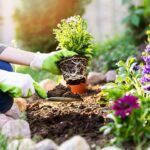Whether you enjoy gardening, you’re probably aware of the importance of having healthy soil for your plants to grow and flourish. One way to achieve this is by combining compost and peat moss in your gardening routine. While compost and peat moss mix have unique benefits, using them together can offer many advantages to your garden soil.
Doing so can help enrich your soil with organic matter, improve its moisture retention capacity, enhance its fertility, and provide your plants with the essential nutrients they need to thrive. In this article, we’ll explore what compost and peat moss are, why you should mix them, and how to do it properly.
An Introduction to Compost and Peat Moss Mix
Before diving into why compost and peat moss work so well together, let’s take a quick look at what they are and what benefits each provides.
What is Compost?

Compost is decayed organic matter that is rich in nutrients. It’s often made by gathering plant-based kitchen scraps, leaves, grass clippings, and other organic materials into a pile or bin and allowing them to decompose over time. Worms and microorganisms help break down the materials into a crumbly, earthy-smelling, nutrient-rich substance.
Compost provides a slow-release, well-balanced supply of nitrogen, phosphorus, potassium, and other trace elements essential for plant growth. Adding compost to the soil improves the soil structure, replenishes nutrients, and increases water retention. Compost also helps suppress plant diseases and pests.
What is Peat Moss?
Peat moss comprises partially decomposed plant material, typically sphagnum moss, accumulated over thousands of years in bogs. It’s light brown and has an acidic pH.
Peat moss has excellent moisture-retaining capabilities. It can soak up water like a sponge and slowly release it as needed. This helps reduce the need for frequent watering. Peat moss also aerates and loosens heavy clay soils to improve drainage. It provides a soft, spongy material for plant roots to spread through.
One downside of peat moss is that it lacks nutrients. However, when combined with nutrient-rich compost, this isn’t a problem!
Why Mix Compost and Peat Moss?
Compost and peat moss have complementary qualities that make them ideal to use together. Here are some of the top benefits of this magical mixture:
Improves moisture retention
Compost tends to drain quickly, while plain peat moss can become waterlogged. By blending them, an excellent moisture balance is achieved. The peat soaks up water like a sponge and releases it slowly to the compost and soil. This means less watering for you!
Loosens and aerates dense soil.
Peat moss is an incredible soil conditioner. It lightens heavy clay soils and loosens compacted dirt. Compost also improves soil structure with added organic matter. Together, they aerate the soil and provide the ideal texture and density for plant roots and beneficial microbes to thrive.
Balances pH levels
Compost has a neutral to slightly alkaline pH, while peat is acidic. Combining the two helps stabilize the pH of your soil. Acid-loving plants like blueberries may appreciate a higher ratio of peat, while other plants benefit from more compost to neutralize some of the acidity.
It provides a diversity of nutrients
Compost delivers a complete package of major and minor nutrients that all plants need – nitrogen, phosphorus, potassium, calcium, iron, and more. Peat moss contributes little in the way of nutrients. When paired, you get the best nutritional profile to feed plants and boost blooms, fruits, and vegetables.
Enhances soil structure and fertility for the long-term
Compost provides an immediate nutritional boost and improves soil structure and fertility over the long run. The organic matter in compost feeds beneficial soil microbes that continue to break down and release nutrients in the soil for many seasons. Peat moss aids in retaining moisture and nutrients in the root zone, so less is lost through leaching.
Suppresses plant diseases
The microorganisms in compost help combat soil-borne diseases like root rot that can affect plants. Peat moss, being slightly acidic, also helps suppress disease organisms. Combining the two gives your plants an extra layer of protection.
As you can see, compost and peat moss complement each other and create an optimal growing environment for your garden. Now, let’s look at mixing and using them correctly in your garden beds or containers.
How to Mix Compost and Peat Moss

Mixing compost and peat moss is simple. Here are some compost and peat moss mix tips:
Choose high-quality components
When buying bagged products, look for compost that appears dark, crumbly, and earthy-smelling. Avoid compost with apparent weed seeds or debris. For peat moss, seek out bags labeled for horticulture use – these are typically shredded finely to mix easily into soil.
Determine the ratio
A commonly recommended blend is two parts compost to 1 part peat moss. But you can adjust the proportions based on your soil needs. For example, use more peat for moisture-loving plants or reduce alkalinity. Or add extra compost for nutrient-hungry vegetables or to help balance the acidity of peat.
Mix thoroughly
Blend the compost and peat moss well until they are evenly distributed. Break up any large clumps. This will help achieve consistent contact and nutrient availability throughout the soil.
Add to native soil.
Mix the compost-peat blend into the top several inches of soil for new garden beds. For container gardening, use the blend to amend potting mixes.
Customize as needed
Add amendments like perlite or vermiculite for further aeration and water retention benefits. Some bone meal or organic fertilizer can provide a nutrient boost for heavy-feeding plants.
Your enriched soil is ready for planting with the compost and peat thoroughly mixed!
Using a Compost and Peat Moss Mix in Your Garden

Here are some of the top ways to utilize compost-peat moss mixes to boost the health and productivity of your garden:
Prepare new garden beds
Work a 2-3 inch layer of blended compost and peat moss into new garden beds before planting. This gives plants a fertile, moisture-retaining soil right from the start.
Fill raised beds
When building a raised bed, fill it with quality potting soil and mix in 1-2 inches of the compost-peat blend. Your veggies and flowers will thrive in the loose, nutrition-packed soil.
Amend existing beds each season
Every spring and fall, top-dress your garden beds with a fresh 1-inch layer of the mix to replenish nutrients and maintain ideal soil structure.
Boost fruiting plants
Give extra care to plants like tomatoes, cucumbers, and berries by mixing the blend into each planting hole before setting transplants. This gets their roots off to a great start.
Pot up containers
Fill pots and planters about 2/3 full with a commercial potting mix, then incorporate a couple of inches of the compost-peat combo. Your container plants will benefit all seasons.
Grow acid-lovers
For rhododendrons, azaleas, blueberry bushes, and other acid-loving plants, use a higher peat ratio in the surrounding soil to maintain the proper pH.
Make seed starting mix
Combine two parts compost, 1 part peat moss, and 1 part perlite for an excellent soilless seed starting mix that provides moisture retention, aeration, and nutrients.
Top-dress lawns
Apply a thin layer of compost-peat blend over grass to provide nutrients, boost microbial activity, and improve moisture retention for a lusher, healthier lawn.
Mulch gardens
Spread an inch or two of the mix over bare soil around plants to help conserve moisture, inhibit weeds, and slowly feed plants as they decompose.
As you can see, the uses for a compost and peat moss blend in the garden are nearly endless!
Frequently Asked Questions
Does the order matter when mixing them?
No, it doesn’t matter which one you add first. The important thing is to mix them thoroughly so they are well-incorporated. Some gardeners add compost first since it contains larger particles that help separate and aerate the finer peat moss.
Can I use vermiculite instead of peat moss?
Yes, vermiculite can be used instead of peat moss to improve soil aeration and water retention. The only downside is that vermiculite does not help improve soil acidity like peat. Use a pH meter to monitor if the soil stays neutral.
How long does the mixture last in the soil?
The compost will degrade over one to three years, while the peat moss can last up to 5 years before replenishment. It’s a good idea to test your soil yearly and re-amend garden beds each spring and fall to maintain optimal nutrition and structure.
Can I use homemade compost instead of bagged?
Yes, homemade compost works wonderfully mixed with peat moss! Just ensure your compost is fully broken down without large debris before using. An immature compost may tie up nitrogen in the soil. Well-made backyard compost rivals or exceeds store-bought products.
Should I add fertilizer, too?
The compost supplies a great balanced nutrition, so extra chemical fertilizer is likely not necessary initially. After a few months, you can top-dress beds with an organic granular fertilizer or compost tea if plants need a nutrient boost. Avoid over-fertilizing, which can do more harm than good.
Conclusion
Improving your existing soil or creating new planting areas using compost and peat moss mix is one of the best things you can do for your garden. Combining peat’s moisture-retention abilities with compost’s nutrient content and soil structure provides ideal conditions for your plants’ roots and growth. Aim for a recommended ratio of 2 parts compost to 1 part peat moss; adjust for your specific needs. Mix thoroughly before adding the enriched blend to your garden beds, containers, or seed-starting mixes. Discover the top 10 best plants for apartment gardening and see how replenishing them annually or as needed leads to healthier plants, more prominent blooms, and bountiful harvests, all with less watering and waste. Get ready for incredible results!











